The Perseid meteor shower was likely to be a lot better this year — so said the folks who presumably know these things. The Perseids typically put on the best display of the year, and it is always fun to get outside of the city in the middle of the night and watch for meteors (and not freeze in the process). This August the earth was going to sweep through a thicker part of the swath of Perseid particles, so instead of the usual 60 meteors per hour, we might be treated to 200 or so per hour! Now that would be sweet! I was fortunate enough to have witnessed the Leonid “meteor storm” in November, 1998 (if I have the year correct), and it would be difficult to ever top that. I was up at Lockwood Valley for that event, when my friend and I were seeing approximately 50 meteors PER MINUTE!
This time around, two other buddies of mine and I headed northwest from the valley towards the same area. We set up in a parking lot near the Chuchupate Ranger Station, west of Frazier Park, at 10:30 p.m. The elevation here is about 5300 feet, and it was on the chilly side already, near 50F. Fortunately, the wind was calm. The skies were nice and clear, as expected, and quite dark, too. This was despite the very bright and obnoxious moon, which was just past first quarter. We would have to wait until 1 a.m. for the moon to set. The summer Milky Way was quite prominent already!
As luck, or bad luck, would have it, we witnessed the most spectacular meteor of the entire night only a minute or two after getting out of the vehicle! This one was a very bright fireball — a “bolide!” — which skimmed the horizon to the east. It moved from south to north and flickered/exploded upon its demise. It was much brighter than Venus ever gets! It happened too soon to be photographed by us, but chances are we would not have had cameras pointed along the eastern horizon, I suppose.
My astronomy-minded friends set up their “astro-trackers” so that their night sky photographs would not show star trails. I wanted to do the same, by piggy-backing my camera on my Celestron 8-inch scope. I dragged that out of the Xterra and then set up its tripod. Now all I needed was my red bag of telescope supplies and…ooops, I left that back in the garage. There will be no piggy-backing tonight for me, because there was no clock-drive power cord for sale or rent at Chuchupate Ranger Station parking area. At least I remembered to bring my other camera tripods, and my lounge chair, and my heavy jacket and gloves, and my batteries were charged. It’s not easy to remember everything.
With the moon still up in the west, I elected to try to photograph some meteors with my 70-200mm telephoto lens. We were seeing a meteor or two every minute, it seemed, which was an excellent rate already. If I shot at 70mm, I would need to be rather lucky to catch a meteor given the narrow field of view. But, the reward might be really nice, so I gave it a try. I tried this for about 10 or 15 minutes, and a bright meteor flashed through Cygnus and the Milky Way, right about where I was pointed! I checked the LCD, and — rats — it missed the field of view, except for a tiny part in the upper right corner!
This may have been the brightest meteor to send photons to my camera’s sensor all night! A little later, one that was not nearly as bright made its way into the frame.
That was much better, but that was as good as it got for the 70mm shots. These were 20-second exposures at f2.8, ISO 2000.
When the moon set, the sky darkened considerably and the meteor count shot up. After midnight is better for viewing, anyway, since we humans on the surface of Earth are in a more favorable orientation for running into them. I had the 21mm lens attached and shot 30-second exposures continuously, primarily towards the Milky Way above, but later towards the east. I even tried a 46mm setting on my 24-80mm lens. I caught perhaps a couple of dozen decent meteors in about three hours of shooting. Unfortunately, I never caught one of the truly amazing fireballs, which we were observing from time-to-time. The three of us decided to count meteors around the 2 a.m. to 3 a.m. hour, and 2-to-3 per minute was about the average rate. In one count, our eyes counted 100 separate meteors in a 23-minute period. We were watching in different directions, naturally, so cut this rate (about 250/minute) in half for one observer. This was truly a magnificent celestial display, by far my second-best meteor show ever! My camera logged about 380 images, mostly 20-to-30-second exposures at 2.8, at ISO settings of 1600 to 3200.
We stuck it out to dawn, and even observed the Zodiacal Light in the east just before dawn. As Orion rose in the east and the faint glow increased, it seemed that the meteors in that direction were getting even more frequent! It was time to pack up our stuff and head home, though. Even though I had a sweatshirt and heavy jacket on, I was getting cold. It was near 40F.
The image below is by Tom Tascone. Tom took a long exposure on film —- 4×5 Crown Graphic Press camera, Fuji Provia 100F at f4.7, 3-hour exposure from 1-4 a.m.
And my other astronomy buddy (Rook) was shooting to the east around 4:45 a.m., and caught this bright meteor. This was with a full frame Canon camera, 50mm lens at f1.4, ISO 2000, consecutive 30-second exposures.
http://www.youtube.com/watch?v=N3uIdHg5AJs&sns=em
Here is a fine selection of my better images on Thursday evening and Friday morning, August 11/12:


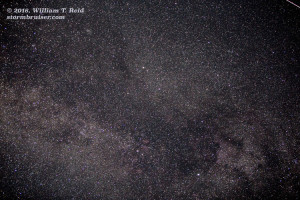
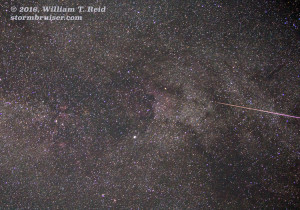
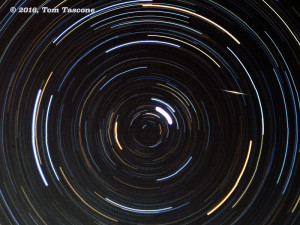
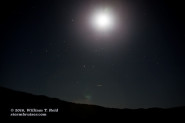

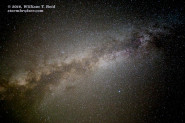
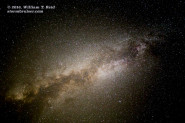
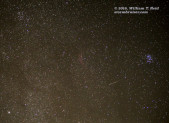
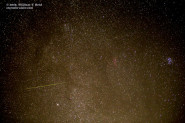
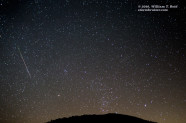
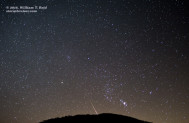
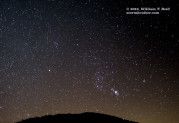
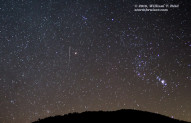
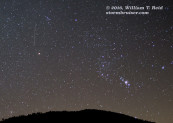
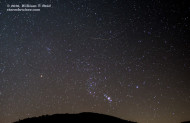
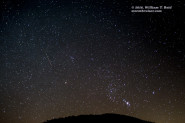
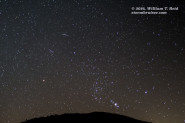
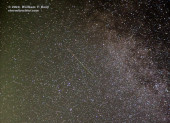
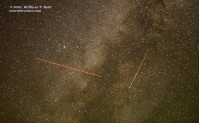
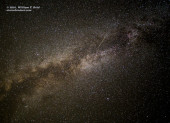
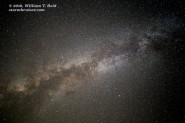
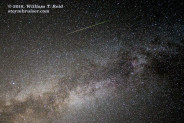
Leave a Reply
You must be logged in to post a comment.